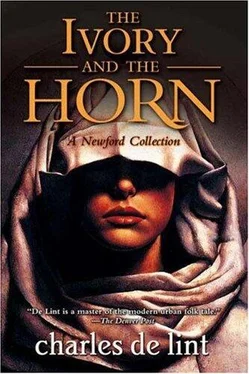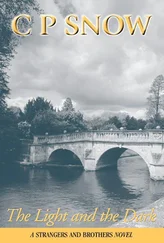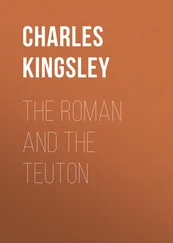"But—"
"Promise me."
For a moment Jean felt as though he didn't know the woman lying in bed beside him. A sliver of moonlight came in through the window, casting strange shadows across Candida's face, reshaping the familiar planes and contours into those of a stranger.
"It's important, Jean. I need to be able to remember this."
"I... promise," he said slowly.
She moved out of the moonlight and the familiar features all fell back into place. The smile that touched her lips was warm and loving.
"When we look back on these days," she said, "we'll remember them as mythic times."
"What do you mean?"
"It's as though we stand in the dark of the moon and anything is possible. We're hidden from the sun's light, from anything that might try to remind us that we only borrow these lives we live, we don't own them."
"If we don't own our lives," Jean asked, "then who does?"
"The people we might become if we stop believing in our dreams."
10
Years later, Jean had trouble remembering all the stories Candida had told him. When he tried to tell them to Sophie, he got them mixed up, transposing this beginning to that ending, the characters of this story into that one, until finally he gave up and read her stories out of books the way other parents did. But he never forgot to remind her to believe in her dreams.
11
Candida went to the store to get some milk one evening, almost three years to the day that they had first met on the back steps of the brownstone, and she never came back, leaving Jean's life as mysteriously as she'd first come into it. He remembered looking at her as she turned back from the doorway to ask if there was anything else she should pick up, and being astounded at the vision he beheld. For one long glorious moment he imagined he saw her bathed in a nimbus of radiant light that shone from her every pore, gold as honey, bright as flames. Wings rose up behind her, huge magnificent feathered wings, each with a span twice her height.
The vision held, one moment, another, and then it was gone, and it was Candida standing there in the doorway, the Candida he'd married and who was the mother of their child. But it was that vision of her that he remembered— as an angel, a faerie, a shaft of moonlight, a gift of wonder that had strayed into his world from some nevernever, drawn by his need, or perhaps her own, to weave the strands of her dreams with his, his with hers. Their time together was too short, far too short, but at least they had had that time together. That was what he reminded himself whenever despair threatened to overwhelm him. The memories... and Sophie... were all that enabled him to carry on.
He remembered Candida as others remember the myths of their ancestors, and he taught their daughter to believe in her dreams. Because in time he came to understand what Candida had meant when she told him that stories begin in dreams and without the stories that we dream, we live someone else's life rather than our own. It wasn't something he realized all at once; instead, he happened upon the fragments of the puzzle, one piece at a time, finding them in the spaces that lay between his memories and his dreams, until one day, when he was sitting alone on the back steps of his apartment building after having put Sophie to bed, the puzzle pieces all came together and he understood.
He smiled then, one of his rare smiles, as sad as it was sweet, but no one was there to see. There were only the stories, the tangled skein of the city's stories, waiting to be shaped by our dreams.
The essential thing in art cannot be explained.
— Pierre-Auguste Renoir
1
— What's it like when you're dead?
— You Still dream.
2
One grey September day, Jilly Coppercorn decided to try to break herself of a bad habit she'd managed to acquire over the years. She'd been working on increasingly larger canvases, which was fine, she had no problem with that, but in the process she'd let herself get so finicky that the clarity of her work was getting bogged down with unnecessary detail. She stood back to look at the bewildering complexity of her latest work-in-progress and realized that, despite the near-perfect rendering of the individual sections, the painting as a whole made no sense whatsoever.
What was the point in developing an ideal composition, she thought, when the detailing eventually came to overwhelm the main point of interest to such an extent that it was subservient to all the fussy specifics around it? The viewer's eye, it was plain, could only become confused as it traveled about the canvas trying to find a point of reference amidst the barrage of detail. All she was going to succeed in doing with work such as this was make the viewer look away and walk over to the next piece hanging on the gallery wall, for relief.
So that day she stopped working in the studio, where the temptation to use big canvases would remain a constant niggle in the back of her head. Instead she took to painting on the street, using her pochade box as a studio. It held everything she needed: six tubes of paint for her limited palette, rag, tissues, a turp can, and a couple of brushes with the handles cut down so that they'd fit into the box. Out on the street, she could hold the box with one hand as though it were a palette, the thumb of her left hand poking up through a small hole in the bottom of the box. When the box was open, the lid formed an easel for the small six-by-eight-inch panels she painted. She used the box's tray for her palette, and, to make sure she didn't get too precious, the smallest brush she took with her was a number 8 oxhair filbert. Her only other equipment was a small drying box to carry her panels and a camp stool that folded flat and could be hung on her shoulder by its strap.
She gave herself thirty minutes per painting, working wet-in-wet, on-site, minimal sketching, minimal detail, looking for the heart of each composition, suggesting detail, not rendering it, concentrating on values and shapes. Most of her time was spent studying her subjects, really thinking through what was important and what wasn't, before she'd squeeze the first dollop of pigment onto her palette. She averaged three to four paintings a day, but quantity didn't interest her. All she was really trying to do at this point was get back to the place she'd been with her art before her preoccupation with detail had taken over.
The habits she'd fallen into were hard to break, but as September drifted into a chilly October and she was well into her second week out on the streets, she was finally making some progress. Rough though the finished pieces were, she was happy with the results she was beginning to get. The small six-by-eight panels forced her to ignore inconsequential details and concentrate instead on essentials: the larger shapes of light and dark, the broader color relationships and the overall composition. She was relearning the ability to portray a scene as a whole, rather than rendering its details piecemeal.
The afternoon she met Tommy Flood, she was sitting on her stool, trying to ignore the brisk nip in the wind as she painted the sweeping lines of St. Paul's Cathedral. She'd lucked into a cloudless day and this late in the afternoon, the light was wonderful. Bundled up against the chill, hands warming in fingerless wool gloves, she was so intent on the play of shadow and light on the cathedral's steps that she didn't realize she had company until Tommy spoke.
"Pretty," he said.
Jilly looked up and smiled at the large man who loomed above her. It was hard to place his age, but she thought he might be in his early thirties. He had the slack features of the simpleminded and returned her smile with one of his own, utterly charming and as innocent as a child's. Around his legs pressed an entourage of scruffy, but amazingly well-behaved dogs: an old black lab, one that looked like a cross between a dachshund and a collie, a couple that had a fair amount of German Shepherd in their mix and one that was mostly poodle.
Читать дальше












